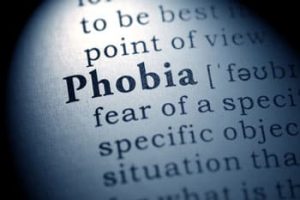 Many people experience specific phobias, intense, irrational fears of certain things or situations–dogs, closed-in places, heights, escalators, tunnels, highway driving, water, flying, and injuries involving blood are a few of the more common ones. Phobias aren’t just extreme fear; they are irrational fear. You may be able to ski the world’s tallest mountains with ease but panic going above the 10th floor of an office building. Adults with phobias realize their fears are irrational, but often facing, or even thinking about facing, the feared object or situation brings on a panic attack or severe anxiety.
Many people experience specific phobias, intense, irrational fears of certain things or situations–dogs, closed-in places, heights, escalators, tunnels, highway driving, water, flying, and injuries involving blood are a few of the more common ones. Phobias aren’t just extreme fear; they are irrational fear. You may be able to ski the world’s tallest mountains with ease but panic going above the 10th floor of an office building. Adults with phobias realize their fears are irrational, but often facing, or even thinking about facing, the feared object or situation brings on a panic attack or severe anxiety.
Specific phobias strike more than 1 in 10 people. No one knows just what causes them, though they seem to run in families and are more prevalent in women. Phobias usually first appear in adolescence or adulthood. They start suddenly and tend to be more persistent than childhood phobias; only about 20 percent of adult phobias vanish on their own. When children have specific phobias — for example, a fear of animals — those fears usually disappear over time, though they may continue into adulthood. No one knows why they hang on in some people and disappear in others.
Specific Symptoms of Specific Phobias
Marked and persistent fear that is excessive or unreasonable, cued by the presence or anticipation of a specific object or situation (e.g., flying, heights, animals, receiving an injection, seeing blood).
The fear is persistent, typically lasting at least 6 months.
Exposure to the phobic stimulus almost invariably provokes an immediate anxiety response, which may take the form of a situationally-bound or situationally-predisposed panic attack. (In children, the anxiety may be expressed by crying, tantrums, freezing, or clinging.)
The fear or anxiety is out of proportion to the actual danger posed by the specific object or situation and is not a typical response in the person’s social or cultural context. Most adults will recognize that their fear is excessive or unreasonable and are bothered by the fact that they have this fear.
The phobic situation or situations are avoided or else are endured with intense anxiety or distress.
The avoidance, anxious anticipation, or distress in the feared situation(s) interferes significantly with the person’s normal routine, occupational (or academic) functioning, or social activities or relationships, or there is marked distress about having the phobia.
The anxiety, panic attacks, or phobic avoidance associated with the specific object or situation are not better accounted for by another mental disorder.
Learn more: Treatment for Specific Phobias
This criteria has been updated for the current DSM-5 (2013).
The DSM-5 diagnostic code for a specific phobia is based on the phobic stimulus:
- 300.29 for a phobia towards an animal (e.g., spiders, insects, dogs), natural environment (e.g., heights, storms, water), or blood-injection-injury (e.g., needles, invasive medical procedures).
- 300.29 if the phobia is situational (e.g., airplanes, elevators, enclosed places) or other (e.g., situations that may lead to choking or vomiting; in children, e.g., loud sounds or costumed characters).
It is common for individuals to have multiple specific phobias. The average individual with specific phobia fears three objects or situations, and approximately 75% of individuals with specific phobia fear more than one situation or object. In such cases, multiple specific phobia diagnoses, each with its own diagnostic code reflecting the phobic stimulus, would need to be given. For example, if an individual fears thunderstorms and flying, then two diagnoses would be given: specific phobia, natural environment, and specific phobia, situational.
This criteria has been updated for the current DSM-5 (2013).
References
American Psychiatric Association. (2013). Diagnostic and statistical manual of mental disorders (5th ed.). Washington, DC: Author.
National Institute of Mental Health. (2019). Anxiety. Retrieved from https://www.nimh.nih.gov/health/publications/anxiety/index.shtml on March 8, 2019.
